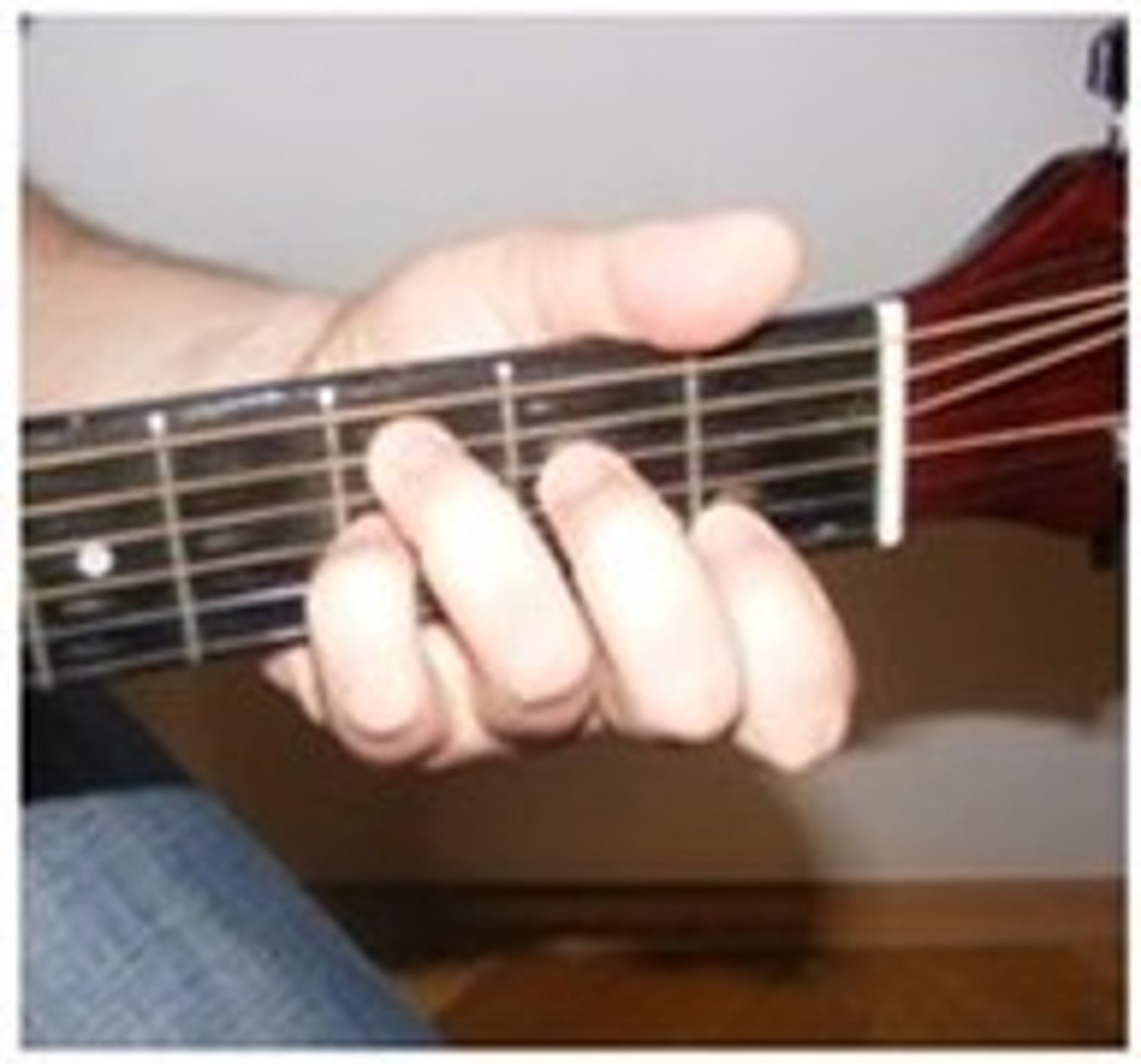
How to Master the C7 Chord in Just a Few Minutes
Master the C7 chord on guitar with ease. Learn finger placement, smooth transitions, and practice tips to add soulful blues and jazz tones to your nice playing!
magicchords.com
10/4/2025


Learn how to play the C7 chord quickly and effectively with this easy guide. Perfect for beginners, discover finger placement tips and practice methods today.
Learning the C7 chord is a fantastic way to add more colour and character to your guitar playing. Unlike standard major chords, the C7 chord introduces a bluesy, soulful sound that instantly transforms simple progressions into something richer and more expressive. For beginners, mastering this chord may seem like a small step, but it opens the door to countless songs across blues, jazz, rock, and pop genres.
🎸 The C7 Chord On Guitar - Post Content:
1. Getting Started with the C7 Chord
2. The Role of the C7 Chord in Music
3. Easy Finger Placement for the C7 Guitar Chord
4. How to Play the C7 Chord Step by Step
5. Frequent C7 Chord Mistakes and How to Fix Them
6. Why Beginners Should Learn the C7 Guitar Chord
7. Practical Tips for Faster Mastery of the C7 Chord
The C7 chord is built by adding a flattened seventh note to the standard C major chord. This subtle change creates tension and depth, making it a favorite in many classic tunes. Even if you are just starting your guitar journey, learning this chord early helps you understand the concept of seventh chords and prepares you for more advanced harmonies. It is also an excellent chord to practice finger placement, stretching, and smooth transitions between positions.


To play the C7 chord, place your index, middle, and ring fingers in the same positions as a regular C major chord, then add your pinky finger on the third string at the third fret. At first, it may feel a little awkward, but with consistent practice your hand will quickly adapt. Adding the C7 chord to your skill set not only improves your versatility but also enhances your confidence when exploring new songs. By practicing slowly and focusing on clarity, you will be able to master this essential chord in just a few minutes and elevate your overall playing.
Guitar tip for beginners 1: When learning to play blues or jazz on guitar, it’s important to understand the connection between chords that create soulful, rich harmonies. Many songs rely on tension and release, which you can easily achieve by combining the C7 chord with the D7 chord in your progression. Practicing both of these dominant seventh shapes not only strengthens your finger dexterity but also helps you recognize patterns that appear frequently in classic tunes, improving your overall musicality and rhythm control.
Getting Started with the C7 Chord
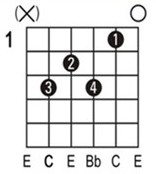

The C7 chord is one of the most important and useful chords you can learn as a guitarist, especially if you are just beginning your musical journey. Unlike the standard C major chord, the C7 adds a flattened seventh note, which creates a slightly bluesy, jazzy, and soulful sound. This small adjustment makes a huge difference in how the chord feels and is a favorite in many blues, jazz, and rock progressions.
To get started with the C7 chord, begin by forming a regular C major shape. Place your index finger on the first fret of the second string, your middle finger on the second fret of the fourth string, and your ring finger on the third fret of the fifth string. Then add your pinky finger to the third fret of the third string. This completes the C7 shape and introduces you to more expressive and versatile chord playing.
The Role of the C7 Chord in Music
The C7 chord plays a powerful role in shaping the sound and mood of music across genres. As a dominant seventh chord, it introduces a tension that naturally resolves to the tonic, making it an essential component in harmonic progressions. While the regular C major chord offers stability and simplicity, the addition of the flattened seventh note in the C7 chord creates a sense of anticipation and movement. This is why it is often described as sounding “bluesy,” “jazzy,” or “soulful.”
In blues, the C7 chord is indispensable. It forms part of the famous 12-bar blues progression, giving songs their characteristic swing and groove. In jazz, the C7 chord often functions as a pivot, smoothly leading into more complex harmonies and improvisational phrases. Even in rock and pop, the chord is frequently used to add color and emotional depth, transforming a simple progression into something far more expressive.
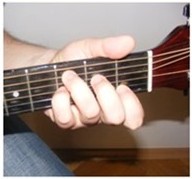

For beginners, learning the C7 chord is a gateway to understanding musical tension and resolution. It helps players recognize how chords interact and why certain progressions feel satisfying. For advanced players, the C7 chord provides endless opportunities for experimentation, whether through substitutions, inversions, or embellishments. Ultimately, the C7 chord’s role in music is to bring energy, drama, and resolution, making it a timeless and versatile tool in any guitarist’s repertoire.
Easy Finger Placement for the C7 Guitar Chord
Learning the C7 guitar chord is much easier than many beginners initially think, and its finger placement makes it one of the most accessible dominant seventh chords to start with. The open C7 chord is just a slight variation of the common open C major chord, which most guitarists learn early on. This means if you can play a C major chord, you’re already halfway to mastering the C7 chord. To begin, place your ring finger on the third fret of the fifth string (A string). Then, set your middle finger on the second fret of the fourth string (D string). Next, put your index finger on the first fret of the second string (B string). This hand shape already forms the familiar C major chord. The crucial change comes with adding your pinky finger: place it on the third fret of the third string (G string). This added note introduces the “flat seventh” that transforms the chord into a C7.
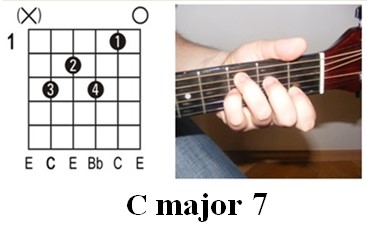

When strumming the C7 chord, avoid playing the low sixth string (E string), as it muddies the sound. Focus your strumming from the fifth string down for the clearest tone. Many players notice that the chord immediately produces a bluesy, soulful resonance compared to the plain C major chord. For beginners, it’s helpful to practice switching between C major and C7 to build finger strength and dexterity. Since the transition only requires adding or removing the pinky, it’s a fantastic exercise for coordination. Mastering the C7 chord’s finger placement not only improves technique but also unlocks the expressive, colorful sound that makes this chord so popular in blues, jazz, and beyond.
How to Play the C7 Chord Step by Step
Playing the C7 chord is a small change from C major that adds a rich, bluesy colour to your music. Hold the guitar comfortably with a relaxed left hand. Start by forming the familiar C major shape: place your ring finger on the third fret of the fifth string, your middle finger on the second fret of the fourth string, and your index finger on the first fret of the second string. Now add the flattened seventh by placing your pinky on the third fret of the third string. Make sure each fingertip presses just behind its fret so notes sound clear.


Strum from the fifth string down and avoid hitting the low sixth string which muddies the chord. Check each string individually, plucking them to confirm they ring without buzzing. If a note is muted, lift and arch the offending finger so it does not touch neighboring strings, and adjust your thumb behind the neck to give fingers better leverage. Practice switching from C to C7 slowly at first, then increase speed with a metronome until the change is smooth. Try incorporating the chord into simple progressions like C to F to G to hear how the dominant seventh introduces tension that resolves nicely. Once comfortable with the open C7, explore movable and barre versions higher up the neck for different voicings. Regular short practice sessions focusing on clarity, finger arching, and relaxed hands will make the C7 chord a reliable and expressive part of your playing.
Frequent C7 Chord Mistakes and How to Fix Them
One of the most common mistakes beginners face when learning the C7 chord is allowing fingers to unintentionally mute adjacent strings. Because the shape requires four fingers in a compact space, improper finger arching often results in muffled notes. To fix this, ensure your fingers are pressing down on their tips, with your thumb resting lightly at the back of the guitar neck to create better reach. Another mistake is pressing too hard, which can cause discomfort and fatigue. The solution is to apply only enough pressure for the note to ring clearly—practice relaxing your grip.


Some players also accidentally include the sixth string in their strum, which muddies the sound of the chord. To prevent this, practice controlled strumming, aiming from the fifth string downward, or lightly mute the low string with the tip of your ring finger. Buzzing sounds are another frequent issue and usually come from placing fingers too far back on the fret. Correct this by moving your finger closer to the fret wire without being directly on top of it. Lastly, rushing transitions between C and C7 can lead to sloppiness. Slow, deliberate practice switching between these chords will build muscle memory and smooth out movements.
Why Beginners Should Learn the C7 Guitar Chord
The C7 guitar chord is one of the most valuable chords for beginners to learn because it introduces them to the world of dominant seventh chords. Unlike a regular C major chord, the C7 adds a bluesy tension that makes music sound richer and more expressive. This small change in sound helps beginners understand how slight variations in chords can completely transform the mood of a song.


From a technical perspective, the C7 chord is not too difficult to play, yet it challenges students to stretch their fingers and improve coordination. This makes it an excellent stepping stone toward mastering more advanced chords. The C7 is also widely used in blues, jazz, rock, and even pop music, so learning it early opens the door to playing a wide variety of songs. For beginners, mastering the C7 chord builds confidence, strengthens technique, and enhances musical creativity.


Guitar tip for beginners 2: Learning to play iconic pop songs on guitar can be both inspiring and educational for beginners and intermediate players alike. One of the most joyful songs to practice is Abba – Dancing Queen Chords, which perfectly captures the uplifting energy and timeless charm of the 1970s. By mastering its chord transitions and rhythm, you’ll not only develop smoother hand coordination but also improve your sense of timing, helping you play along confidently with your favorite songs and enhancing your overall musical expression.
Practical Tips for Faster Mastery of the C7 Chord
Mastering the C7 chord can feel a little challenging for beginners, but with the right approach, it can become second nature much faster. One of the most practical tips is to start by learning the correct finger placement slowly and carefully. Place each finger deliberately, making sure every string rings out clearly. This attention to detail at the beginning will prevent the development of bad habits later on. Repetition is another key to faster mastery. Practice moving your fingers on and off the chord repeatedly without strumming. This builds muscle memory so your hand will instinctively know where to go. Once the shapes feel comfortable, add strumming to hear how the chord sounds in context. Combining visual, tactile, and auditory practice reinforces learning.


It is also very helpful to practice chord changes involving C7, especially moving between C major, F major, and G7 chords. These transitions are common in songs and will strengthen your ability to apply C7 musically. Incorporating rhythm exercises with downstrokes and upstrokes will further improve fluency. Finally, practice in short, frequent sessions rather than long, infrequent ones. A few minutes of focused practice each day will speed up progress significantly and make playing the C7 chord effortless.
Strumming the C7 Chord with Ease and Confidence
Strumming the C7 chord with ease and confidence begins with building a relaxed and natural technique. Many beginners focus heavily on finger placement and forget that the right hand is equally important in producing a smooth, musical sound. To strum the C7 chord confidently, start by holding the pick loosely but securely, allowing it to glide across the strings without forcing the motion. A stiff grip can create a harsh, uneven tone, while a relaxed hand encourages fluidity.
Begin with simple downstrokes, making sure each string rings clearly. Once comfortable, add alternating upstrokes to develop a steady rhythm. Practicing slowly at first ensures precision, and gradually increasing speed will bring fluency. It is also helpful to practice with a metronome, as this builds timing and prevents rushing or dragging the beat.


Experimenting with different strumming patterns can make the C7 chord come alive. Try emphasizing certain beats or muting the strings lightly with the palm of your hand to add variety and groove. Playing along with blues or jazz tracks that feature the C7 chord can also boost confidence, as it provides a real musical context. With consistent practice, strumming the C7 chord becomes smooth, expressive, and enjoyable, enhancing overall guitar playing.
Mastering Smooth Transitions To and From the C7 Chord
Smooth transitions to and from the C7 chord are an essential skill for guitarists who want their playing to sound polished and natural. Many beginners struggle with chord changes because their fingers hesitate or move one at a time. To overcome this, focus on keeping your fingers close to the fretboard and practice lifting and placing them together as a group. This reduces wasted motion and makes every transition quicker.
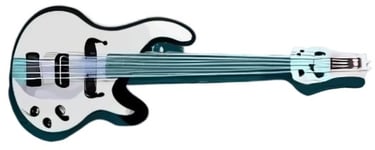

A helpful method is to practice moving between C major and C7, since the shapes are very similar. This allows you to build confidence with minimal adjustment while training your fingers to adapt. Once this feels comfortable, add transitions between C7 and chords like F, G7, and A minor, which appear often in songs. Play these changes slowly at first, paying attention to clarity, then gradually increase speed. Using a metronome during practice helps maintain steady rhythm while shifting chords. With patience, repetition, and relaxed hand movement, the C7 chord will fit seamlessly into your progressions, making your playing smoother and more expressive.




